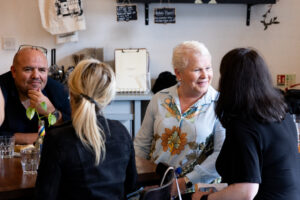
We’re living in the noisiest marketing environment in history. The average person now encounters up to 10,000 marketing messages a day – from inboxes and banner ads to pop-ups and billboards. The result? People are switching off. They’re skipping ads, muting notifications and walking away from digital altogether.
This isn’t just a hunch; it’s a well-documented shift, and the data backs it up.
- 69% of consumers say they’re overwhelmed by the volume of digital communication.
- 65% of YouTube users skip ads as soon as possible.
- 61% of people ignore most social media ads entirely.
The digital tactics that once brought in leads and conversions with minimal spend aren’t delivering like they used to. The landscape has become crowded, and these marketing methods have become more expensive, less effective and increasingly outdated.
But here’s where many small businesses can find real opportunity – to reset, refocus and return to what marketing has always been about: real human connection.
Human-to-Human (H2H) Marketing – Why Relationships Matter More Than Ever
The real shift we’re seeing at Finesse is towards a growing ‘unplugged’ movement, especially among younger generations. People are deleting the apps, leaving social platforms and becoming more selective about what they engage with.
That means the way we communicate has to change. It’s no longer about being everywhere. It’s about being relevant, showing up where it matters, and doing so in ways that feel genuine.
So, how can you do that? By creating meaningful interactions. By speaking to people with authenticity. It’s not about chasing every trend or automating every touchpoint; it’s about being real and building trust that lasts.
Looking After Your Existing Clients Is the Growth Strategy You Can’t Ignore
Let’s be honest, most of us focus more on finding the next lead than nurturing the clients we already have. But when we overlook those existing relationships, we miss one of the biggest drivers of sustainable growth.
If you’re wondering whether focusing on retention moves the needle, the numbers tell a compelling story:
- A 5% increase in customer retention can lead to a 75% increase in profits.
- The likelihood of selling to a new prospect is just 5–20%, whereas the likelihood of selling to an existing customer is 60–70%.
It’s a powerful reason to shift from chasing quick wins to building long-term relationships. Because when we invest in loyalty, clients come back. They spend more. They refer others. That consistency brings real stability to your marketing – and your growth.
Connection Matters More Than Clicks

Not long ago, marketing felt simple. You’d post on social media, put a bit of budget behind it, and see results roll in. But those days are behind us. Algorithms are shifting and ad costs are climbing. It’s also becoming harder to measure what’s working.
In 2025, attention alone isn’t enough. What matters today is connection – meaningful, relevant, human connection.
Effective marketing is no longer about broadcasting to everyone. It’s about engaging the right people at the right moment – not only as potential clients, but as individuals who want to feel heard, understood and supported.
This kind of connection does take time, but it also builds trust. And trust is what drives lasting and sustainable growth.
Embracing AI in Marketing Without Losing Connection Requires a Human Touch
AI is changing the way we work – and fast. There’s a lot of buzz about AI, and rightly so. But here’s the thing: embracing AI doesn’t mean sacrificing the human side of your marketing.
Used wisely, AI gives us something every business needs. Time.
Time to focus on what matters most: relationships, insight and creativity.
Yes, AI can handle admin, organise data and even help spark ideas. But the real value? It’s what that space allows you to do – connect more deeply with your clients, craft smarter strategies and stay focused on meaningful growth.
Smart businesses are using AI not to replace human interaction, but to enhance it.
Make Your Brand More Relatable with Practical Human Marketing Strategies
Here are five ways to apply human-to-human thinking in your marketing today, using real-world examples that show the impact of thoughtful, client-first connections.
1. Start Real Conversations with Your Existing Clients
People are tired of being talked at. They want to be heard. Humanising your marketing is about moving away from one-way messaging to meaningful dialogue.
For example, an education provider could ask their students not only about their academic level, but also about their learning styles, preferences and personality. They could use AI to match students with teachers who fit both their academic needs and their unique learning style.
The result? Greater engagement, more satisfaction and a far more human experience.
2. Put Real People at the Centre of Your Brand
Real connection and trust don’t come from a logo. They come from people. So, how can you bring more of your people into your marketing?
One of our clients – DigiTally, a food waste company – wanted to raise its profile in a highly niche space, but traditional digital tactics weren’t cutting through. Instead of spending more on ads, they worked with Finesse to host small, in-person roundtable dinners at quirky London venues. The goal wasn’t to pitch; it was to talk and connect.
The outcome? Real business built through real connection.
3. Personalise the Client Experience
Personalisation isn’t about dropping a name into an email. It’s about showing you understand someone’s preferences and values. According to McKinsey, brands that personalise effectively see 40% more revenue, yet only 60% of clients feel companies are getting it right.
For example, certain hospitality providers ask guests ahead of arrival whether they prefer sparkling or still water, soft or firm pillows, or even if they’d like wine in the room – and offer a thoughtful alternative for guests who don’t drink.
Remember: Small, human touches create standout memories and keep customers coming back.
4. Make It Easy to Refer You
Referrals still deliver some of the highest-quality leads when done with integrity.
Pubjar, a UK-based tea company, launched on a shoestring budget and focused on building a community. Their waiting list strategy rewarded people for inviting friends – not with gimmicks, but with simple, thoughtful incentives. Over 60% of their early growth came through word of mouth, earning them £1 million in revenue in just six months.
5. Use Experience to Build Emotional Loyalty
Good service is remembered, but great experiences are shared.
For example, a pet wellness brand built emotional connection in unexpected ways. They sent handwritten notes, personalised follow-ups and even flowers to grieving clients. These gestures didn’t just drive retention; they created community. And community, more than any campaign, is what builds long-term brand value.

The Key Takeaway: Human-to-Human Marketing and Client Loyalty Should Lead Your Strategy in 2025
In a digital world that’s busier, faster and more disconnected than ever, human marketing stands out. It’s more thoughtful, more effective and more sustainable. It also aligns more with how people actually want to engage.
Instead of chasing the next trend or quick win, smart businesses are turning their focus to the relationships they’ve already built. Because when people feel seen, heard and genuinely valued, they remain, return and refer.
They help you build the kind of business that lasts.

Want to incorporate human-to-human marketing into your strategy in 2025? Book a free 30-minute call with Jo and let’s explore what loyalty could look like in your business.

